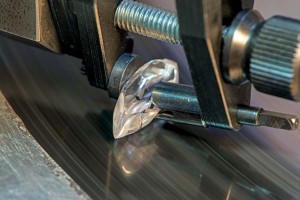Planning Esperanza

The crystal could best be described as an elongated dodecahedron—it had only one slight protrusion that defined one cube face (100) and one dodecahedral face (110).* There were no trigons, but there were three misshapen triangular protrusions with poor definition that indicated an approximate octahedral face (111). There were no visible inclusions in the diamond except for a very small cavity toward one of the points that only extended slightly into the stone. “When I saw the morphology of the crystal in person, it confirmed my initial perception that this should be a triolette design,” Mike said. “The diamond was more pointed at one end than the other, and the end view suited a triangular configuration way better than round.”
Using CAD software, Mike recreated Esperanza’s triolette design to establish precise angles and indices for the facets, an extremely tedious process in itself. By now, he had planned a blueprint of what the finished stone would look like. However, there was still one critical component to the puzzle that needed to be defined: the faceting sequence. He ran through many possibilities in his mind, reflecting on the approach he took with the previous triolette. After going through all the various iterations, he created the faceting sequence, which also allowed him to select the right equipment for the cutting process. Given the shape of the rough crystal, Mike decided to cut Esperanza as a whole, without any pieces sawn off.





